Operating any business comes with a certain amount of risk and reward. Working with people of any age, especially those who need medical services, increases both the risks and the rewards.
The biggest reward is knowing that you’ve helped someone. The biggest risk is often from injury-causing accidents.
You didn’t go into the business of helping the elderly to cause any harm. The opposite is true. Whether it’s a nursing home, an assisted living facility, or even a retirement community, you opened your doors to help our aging population.
The reality is that problems happen. A study, conducted by the Office of the Inspector General for the U.S. Department of Health and Human Services, looked at the care for Medicare beneficiaries from 2008 to 2012. In that time, 22 percent of patients experienced an adverse event – an injury of some kind. Of those events, 59 percent were found to be preventable.
WHAT CAN YOU DO TO HELP THOSE IN YOUR CARE AND YOUR BUSINESS?
An excellent way to prevent unnecessary and avoidable injuries is to keep your policy and procedure documents accurate and current. For the prevention of accidents, you should consider at least two separate manuals.
BUILDING AND EQUIPMENT ISSUES
Accidents and injuries from improperly functioning equipment are not only hazardous for patients and employees but can increase your insurance premiums if too many claims are received. The best cure is preventative maintenance. If you don’t already have one, you’ll want to create and then update a policy and procedures manual specific to your building and equipment.
The manual should include:
- A schedule of routine inspections
- An annual inventory of equipment
- A maintenance schedule for equipment – weekly, monthly, or annual
- Logs for each piece of equipment – include found problems and corrective services/replacement
- Inspection checklists
- System for work orders and service requests
WOUND CARE
When an accident occurs, wounds are possible. In order to make sure that everyone receives quality care, and to prevent further complications, policies and procedures should be in place for wounds as well. The focus of this manual should be on accepted standards of practice, research-driven clinical guidelines, and interdisciplinary involvement. Having this in place helps ensure that everyone receives medically and scientifically based care while communicating with each other.
The manual should include information on the following:
- Accountability – program oversight, staff involvement in prevention and treatment, expectation of caregivers to observe and monitor
- Admission wound assessment
- Ongoing wound assessment
- Wound management
- Wound care
- Documentation and care planning
- Notification procedure – physician, family, and other staff
- Education of staff
Your elder care facility needs to have the proper insurance policies in place. That doesn’t mean that you should need to use it all the time. Lowering your elder care facility insurance costs begins with lowering your risk. Policies and procedures that prevent and minimize accidents in your nursing home or assisted living facility are a good step in the right direction. Once you write those policies and procedures, make sure that your entire staff is following them – hold them accountable, and update them as needed. Your risk of an insurance claim, or worse, a lawsuit will decrease.
Best of all, your patients will be better off for it.
Image courtesy of Flickr user jkfid.

